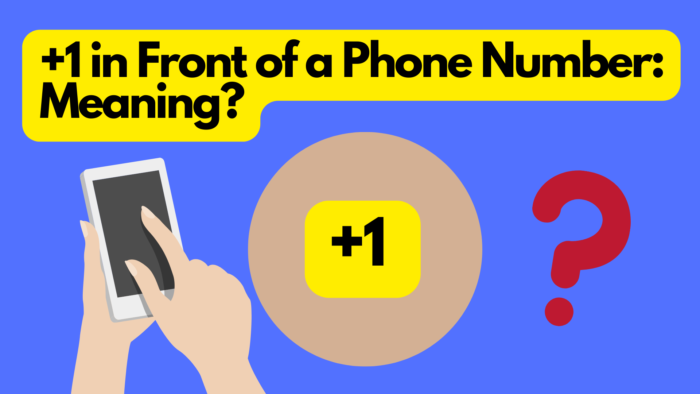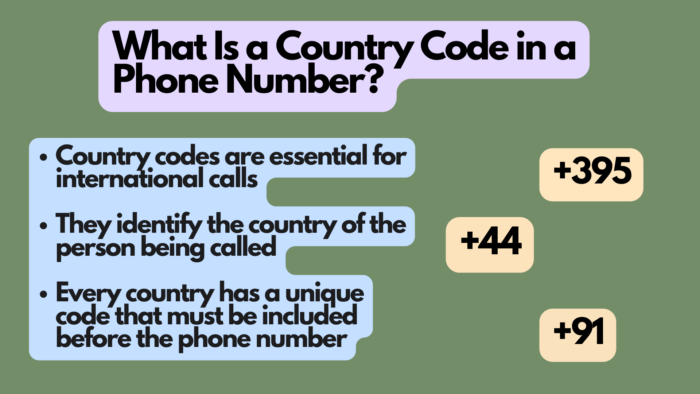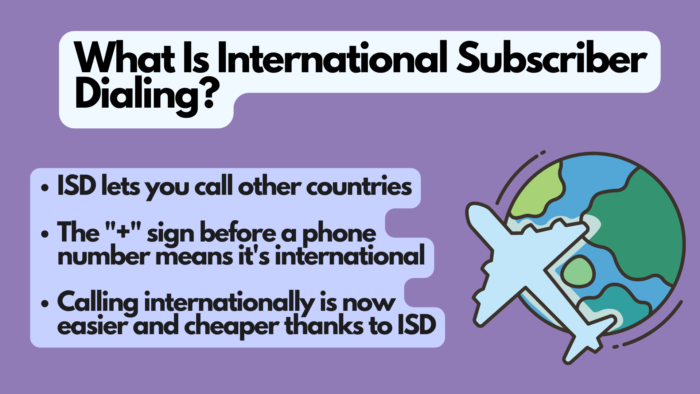Have you ever wondered what +1 in front of a phone number means? It refers to the country code of the dialer, and it is included before a 1 phone number. Every country has its unique country code, but some countries share codes, like the United States and Canada. When someone calls you, their phone number will include the code for the country they are calling from. If you’re curious about the reason behind North America’s use of +1 in front of a phone number, you’ve come to the right place. In this article, we will explore everything you need to know about international subscriber dialing and how to use country codes, as well as the history behind North America’s use of +1. So, let’s dive into it!

What Is a Country Code in a Phone Number?

A country code is a numerical prefix that is added to a phone number to indicate the country or region where the call is originating from. This code is necessary for making international phone calls as it allows the call to be routed to the correct country. The country code is typically represented by a plus sign (+) followed by a numerical code, which can be one to three digits long.
One common country code is +1, which is used by North America. This code is often seen in front of phone numbers originating from the United States, Canada, and other countries in the region. When you see a phone number with 1 in front of it, it typically means that the call is originating from North America.
It’s important to note that not all phone numbers in North America start with 1. However, many do, and if you see a phone number starting with 1, it’s likely that it’s a North American number. In fact, the 1 in front of the phone number is actually the country code for North America.
When making international calls, it’s crucial to use the correct country code. If you don’t use the right code, the call may not be routed correctly and could end up going to the wrong destination or not connecting at all. To find the right country code for a particular phone number, you can use an online search tool or consult a phone book or directory.
What Is the International Telecommunication Union Standard?
International Subscriber Dialing (ISD) is a telephone numbering plan that allows users to make long-distance calls to other countries. This system uses a unique set of codes to enable international calling. These codes are usually represented by a plus sign (+), followed by a country code, area code, and telephone number.
The plus sign indicates that the following numbers are an international telephone number. It is equivalent to dialing the international access code used in the country where the call originates. The country code is a three-digit code that represents a particular country. The area code is a three-digit code that identifies a specific geographical location within the country. The telephone number is the local number of the person being called.
In North America, the country code is represented by the number 1. Therefore, if you see a telephone number that starts with the number 1, it is a North American phone number. However, the number 1 does not always indicate an international telephone number. Sometimes, it is used as an area code or a prefix for a local phone number.
To make an international call using ISD, you need to enter the plus sign followed by the country code, area code, and the telephone number. For example, if you want to call someone in the United States from India, you would dial +1 (country code for the United States) followed by the area code and telephone number. The + symbol can be replaced by the international access code used in India, which is 00.
What Is International Subscriber Dialing?

International Subscriber Dialing (ISD) is a telephone numbering plan that enables people to make long-distance calls to other countries. The prefix that precedes a phone number is significant as it indicates the type of call. In the case of ISD, the plus sign (+) preceding a phone number denotes an international call. This sign is the equivalent of the international access code used in the originating country.
When it comes to the United States and Canada, the number 1 before a phone number signifies that it is a North American phone number. This is because the North American Numbering Plan (NANP) includes these two countries, along with several other countries and territories in the Caribbean.
Therefore, a phone number starting with 1 belongs to either the United States or Canada. The area code and the following digits of the phone number would then identify the specific location and the local number of the person being called.
ISD has made it possible for people to connect with their loved ones or business associates in other countries with ease. It has significantly reduced the cost of international communication and has helped to bring the world closer together.
In conclusion, ISD is a telephone numbering plan that enables people to make long-distance calls to other countries. The plus sign that precedes a phone number indicates an international call. The number 1 before a phone number indicates that it is a North American phone number.
When Do You Use Country Codes?
Country codes are essential when making international calls. They help to identify the country where the person being called is located, ensuring that the call reaches the correct destination.
You use country codes when you want to make a call to another country from your own. Every country has a unique code that is assigned to it, and this code needs to be included before the phone number when making an international call.
Without the correct country code, the call may not connect, or it could end up being directed to the wrong country altogether. Using the country code also ensures that you are charged the appropriate international calling rates.
Most mobile phones and landline providers automatically add the country code when dialing an international number. However, it is still essential to double-check the number to make sure that the country code is included.
In conclusion, country codes are crucial when making international calls. They ensure that the call reaches the correct destination and that you are charged the appropriate international calling rates. You use country codes when making calls to other countries from your own, and it is essential to double-check that the correct code is included before making the call.
How Do You Use Country Codes?
Using country codes may seem confusing, but it is relatively straightforward once you know how to do it. The first step is to identify the country code for the country you wish to call. You can find this information online or by consulting with your phone or service provider.
Once you have the country code, you need to add it to the phone number you want to call. The country code should be added at the beginning of the phone number and should be preceded by a plus sign (+). For example, if you want to call a number in the United Kingdom, you would add the country code “+44” before the phone number.
It is important to note that some countries may have additional codes that need to be added before the country code. For example, if you are calling to a mobile phone in India, you need to add a “0” before the country code.
Once you have added the country code and any additional codes, you can dial the complete phone number and initiate the call. Most modern mobile phones and landline providers will automatically add the country code when dialing an international number, but it is still essential to double-check the number to make sure that the correct code is included.
In conclusion, using country codes is a simple process that involves identifying the country code for the country you wish to call and adding it to the beginning of the phone number. Some countries may have additional codes that need to be added before the country code. Once the correct code has been added, you can dial the complete phone number and initiate the call.
Why Does North America Use +1 in Front of a Phone Number?
In North America, phone numbers are identified with the country code “+1.” This code is used for North American phone numbers, including those in the United States, Canada, and other countries.
The use of this code helps to create a standard way to recognize phone numbers in North America, which makes it easier to communicate and dial between countries. It also helps to differentiate between domestic and international calls, making it clear that a phone number with the +1 code is an international call to North America.
Additionally, the +1 code is crucial for international calling because it helps to route calls to the correct country and phone number. If the country code is not used, the call may not be directed properly, which can lead to the wrong party being reached or a failed connection.
To summarize, the +1 code is essential for identifying North American phone numbers and for making international calls to the region. Its use promotes clear communication, facilitates proper call routing, and helps prevent confusion between domestic and international calls.
Finding the Right Country Code
To make an international call, you need to know the correct country code for the phone number you’re calling. Fortunately, finding the right country code is easy online.
Several websites and tools allow you to search for country codes by country name or phone number. You can also use search engines like Google to find the country code quickly. Simply type in the country name and “country code” or “international dialing code” to get a list of results with the information you need.
Another way to find the right country code is to check a phone directory or contact the recipient of the call directly. They should be able to give you the correct country code and any other necessary information you need to make the call.
It’s important to note that country codes can change over time. Therefore, make sure you have the most up-to-date information before making an international call. Double-checking the country code before dialing can save you time and frustration by ensuring that your call is properly connected.






You must be logged in to post a comment.